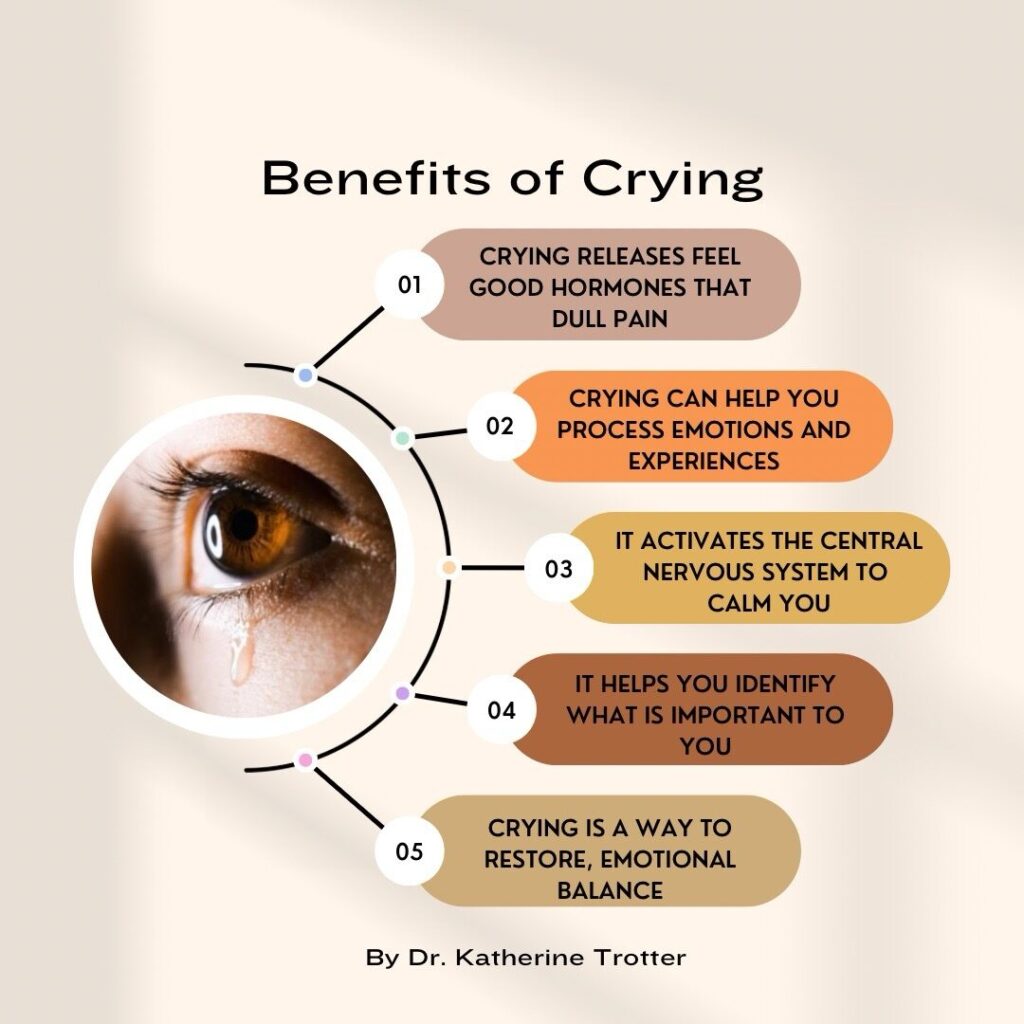
We’ve all been there: a breakup blindsides you, a frustrating situation boils over, or a sad movie tugs at your heartstrings. Tears well up, your vision blurs, and suddenly you’re a sniffling mess. Crying often gets a bad rap, associated with weakness or negativity. But what if we told you there’s more to crying than meets the eye? Buckle up, because we’re diving into the surprising benefits of crying, and why it might actually be good for you.
Beyond Sadness: A Spectrum of Tears
First things first, not all tears are created equal. We produce three main types of tears:
- Basal tears: These are the unsung heroes, constantly lubricating our eyes to keep them healthy. Think of them as the windshield wipers keeping your vision clear.
- Reflex tears: Ever chopped an onion and ended up in tears? Reflex tears are your body’s way of flushing out irritants like dust or smoke.
- Emotional tears: Ah, the ones we usually associate with crying. These tears are triggered by a whole range of emotions, from sadness and grief to joy and relief.
It’s these emotional tears that hold the key to unlocking the surprising benefits of crying.

The Science Behind the Sniffles
Science is starting to catch up with what many of us have intuitively known: crying does more than just make your face wet. Here’s a peek at the fascinating science behind a good cry:
The Chemical Cocktail of Catharsis
When we cry emotionally, our bodies release a cocktail of chemicals. Stress hormones like cortisol and adrenocorticotropin (ACTH) decrease, leading to a feeling of calm. Additionally, endorphins, the body’s natural painkillers, are released, offering relief from both physical and emotional discomfort.
Think of it like this: after a tough workout, your body releases endorphins to ease muscle soreness. Crying might just be an emotional workout, releasing tension and promoting a sense of well-being.
Tears: A Window to Our Emotions
Research suggests that emotional tears contain not just water and salt, but also proteins and other chemicals unique to each individual. These unique components might act as a signal to others, subconsciously communicating our emotional state and potentially promoting empathy and social bonding.
Imagine crying after a fight with a loved one. Your tears might be a way of expressing your hurt and inviting them to offer comfort.
The Emotional Payoff: How Crying Can Help You Heal
So, how does all this science translate into real-life benefits? Here are some ways crying can actually help you:

- Reduce stress and improve mood: Crying helps your body release pent-up stress hormones, leaving you feeling calmer and more relaxed.
- Process grief and loss: Tears can be a healthy way to express and release the pain associated with loss.
- Boost the immune system: Some studies suggest that emotional tears contain substances that help fight bacteria.
- Improve sleep: Crying can be emotionally draining, leading to a feeling of exhaustion and promoting better sleep.
- Strengthen relationships: Crying in front of a loved one can create a sense of vulnerability and intimacy, strengthening your bond.
Crying Doesn’t Fix Everything: When to Seek Help
While crying offers a wealth of benefits, it’s important to remember it’s not a cure-all. If you’re experiencing persistent sadness, overwhelming emotions, or difficulty coping with daily life, seeking professional help from a therapist or counselor is crucial.
Read Also
- Creativity and mental illness: is there a link?
- Tips for effective communication in the workplace
- Creative Hobbies to Pick up in Your Free Time
It’s Okay Not to Be Okay: Normalizing the Emotional Release
Crying is a natural human response. It’s a way of expressing our emotions, processing difficult experiences, and finding emotional release. So next time you feel the tears welling up, don’t hold them back. Embrace the sniffles, let it out, and know that you’re doing your body and mind a favor.
FAQs
1. Is crying a sign of weakness?
Absolutely not! Crying is a healthy emotional response that shows you’re in touch with your feelings. In fact, suppressing emotions can be more detrimental in the long run.
2. What if I can’t cry?
Sometimes, due to emotional repression or certain medications, people struggle to cry. If this concerns you, it’s best to speak to a doctor or therapist.
3. How can I create a safe space for crying?
Find a quiet, comfortable place where you can be alone and express your emotions freely. Talking to a trusted friend or family member can also create a safe space for releasing tears.
4. Are there cultural differences in crying?
Yes, cultural norms around crying can vary. In some cultures, it’s seen as a sign of weakness for men to cry, while in others, public displays of emotion are more accepted. It’s important to be mindful of these cultural differences and create a space for emotional expression that feels comfortable for you.
5. How can I help someone who is crying?
The most important thing is to offer empathy and support. Listen without judgment, offer a hug or comforting touch (if appropriate), and let them know you’re there for them.
Crying is a natural part of the human experience. By understanding the science behind tears and embracing the emotional release they offer, we can all learn to navigate difficult emotions in a healthier way. So next time you feel a wave of emotion coming on, remember: it’s okay to let it out. Cry it out, breathe it out, and know that you’re not alone.

